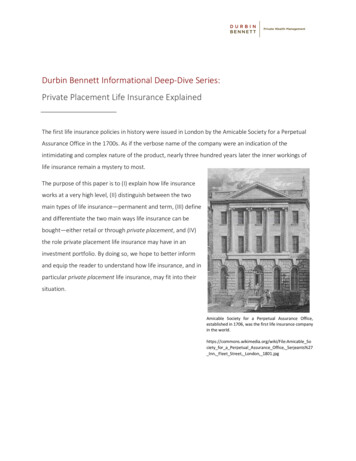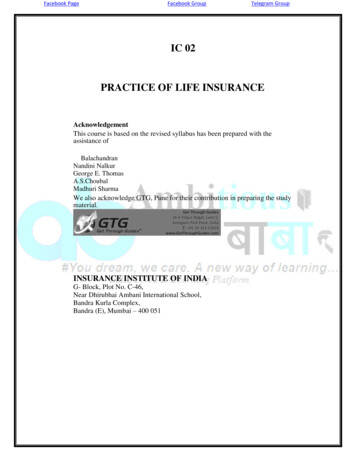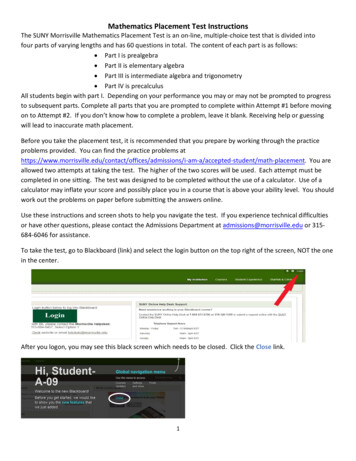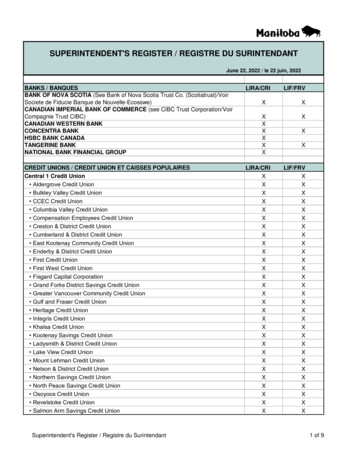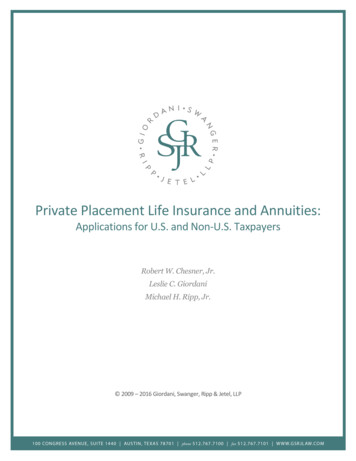
Transcription
Private Placement Life Insurance and Annuities:Applications for U.S. and Non-U.S. TaxpayersRobert W. Chesner, Jr.Leslie C. GiordaniMichael H. Ripp, Jr. 2009 – 2016 Giordani, Swanger, Ripp & Jetel, LLP
Table of ContentsI.Introduction to Private Placement Life Insurance and Annuities.1A. A Tax, Estate, and Investment Planning Tool with Multiple Applications .1B. Private Placement Variable Universal Life Insurance (“PPLI”) .2C. Private Placement Deferred Variable Annuities (“PPVA”) .2II. Ensuring Compliance as a U.S. Qualifying Product.3A. U.S. Tax Treatment of Life Insurance.31. Qualifying as a Life Insurance Contract .3a. Cash Value Accumulation Test (“CVAT”).3b. Guideline Premium Test (“GPT”) and Cash Value Corridor Test (“CVCT”).42. Section 7702A: Non-MEC vs. MEC.4a. 7-pay Test.4b. Treatment of Material Changes .43. Section 817: Special Rules for Variable Contracts .5a. Diversification .6(1) Test.6(2) Timing .6(3) Grace Period, Inadvertent Failure, and Market Fluctuations .7(4) Treatment of Funds.7(a) Insurance Dedicated Funds .8(b) Non-Insurance Dedicated Funds .8b. Investor Control .8(1) Conduct Deemed to be Investor Control.8(2) Special Issues Relating to Managed Separate Accounts .9(a) Definition .9(b) Rev. Rul. 2003-91 and Related Rulings .9(c) Note of Caution . 11B. U.S. Tax Treatment of Annuities . 121. Qualifying as an Annuity. 122. Section 72: Annuity Contract Defined . 12C. U.S. Securities Treatment of PPLI and PPVA . 131. Qualification as an Accredited Investor and Qualified Purchaser . 132. Special Considerations for Non-U.S. Policies . 13III. Tax Treatment of Life Insurance and Annuities. 13A. Introduction to Federal Income Tax Treatment of U.S. Citizens and Residents As Compared with NonResident Aliens (“NRAs”) . 13B. Income Tax Rules Applicable to U.S. Taxpayers Who Own Life Insurance Policies . 141. Non-Taxation of Internal Build-Up . 142. Distributions During Policy Term . 14a. Non-Modified Endowment Contract Distributions . 14b. Modified Endowment Contract Distributions . 153. Surrender or Maturity of Policy . 164. Policy Proceeds . 165. Transfer for Value Rule. 166. Section 4371: Excise Tax on Life Insurance Premiums Paid to Foreign Insurers. 177. Section 1035: Tax-Free Exchange . 17
C. Income Tax Rules Applicable to Non-U.S. Taxpayers who Own Life Insurance Policies. 171. Generally Similar to Rules for U.S. Taxpayers . 172. Taxable Amounts Subject to Withholding . 17D. Transfer Tax Rules Applicable to U.S. Taxpayers Who Own Life Insurance Policies . 181. U.S. Estate Tax Rules. 182. U.S. Gift Tax Rules . 18E. Transfer Tax Rules Applicable to Non-U.S. Taxpayers who Own Life Insurance Policies . 191. Taxation of Transfers of U.S.-Situated Assets . 192. Section 2105 . 19F. Income Tax Rules Applicable to U.S. Taxpayers who Own Annuities . 201. Tax During Accumulation Period . 202. Tax During Annuitization Period . 213. Tax Following Annuitant’s Death. 21G. Income Tax Rules Applicable to Non-U.S. Taxpayers who Own Annuities . 221. Generally Similar to Rules for U.S. Taxpayers . 222. Withholding . 223. Original Issue Discount (“OID”) Problem Applying to Non-U.S. Issued Private Placement VariableAnnuity Contracts . 23H. Transfer Tax Rules Applicable to U.S. Taxpayers who Own Annuities . 23I. Transfer Tax Rules Applicable to Non-U.S. Taxpayers who Own Annuities . 23IV. Planning Strategies. 24A. Domestic vs. International PPLI . 241. In General. 242. Statutory Asset Protection . 25B. Planning for the U.S. Taxpayer. 251. Domestic Gifting Trust Ownership of Policy . 252. Irrevocable Life Insurance Trusts (on a Grand Scale) . 26a. Lifetime Exclusion Gifting. 27b. Private Split-Dollar Funding . 27c. The Impact of Section 684 on International ILITs . 28C. Planning for Foreign Non-Grantor Trusts with U.S. Beneficiaries. 291. What is a Foreign Non-Grantor Trust (“FNGT”)? . 292. Background: Pre-1996 Tax Framework . 303. Post-1996 Tax Framework . 314. Tax Consequences of Foreign Non-Grantor Trust . 31a. Distributable Net Income (“DNI”). 31b. Undistributed Net Income (“UNI”) . 31c. Accumulation Distributions . 325. PPLI as a Solution to the Accumulation Distribution Problem . 32a. In General. 32b. Modified Endowment Contract (“MEC”) . 33D. Planning for Foreign Persons Residing Temporarily in the U.S. . 33V. Investment Considerations as Tax Rates Increase . 35VI. Reporting of Foreign Bank Accounts and Assets . 36A. Foreign Bank Account Report (“FBAR”) Regulations . 36B. Form 8938-Statement of Specified Foreign Financial Assets . 37
I.Introduction to Private Placement Life Insurance and AnnuitiesA.A Tax, Estate, and Investment Planning Tool with Multiple ApplicationsSuccessful advisors of high net worth individuals employ a holistic approach to their clients’planning, one that addresses all of the clients’ goals simultaneously, rather than focusing oncomponent goals in isolation. It requires the advisor to construct a plan that encompassesmultiple areas of concern in a simple and understandable manner, that meets clients’ needs,and that recognizes the interrelationship of those areas. Essentially, it means that advisorsmust consider investments, income taxation, transfer taxation, asset security, andphilanthropy in unison to achieve optimal results.This article examines private placement life insurance (“PPLI”, also known as privateplacement variable life insurance) and private placement variable annuities (“PPVA”), twocore planning strategies that allow holistic advisors to address a wide variety of client needs.As an investment tool, both PPLI and PPVA enable access to sophisticated investmentstrategies used regularly by high net worth investors. As an income tax planning tool, PPLIreduces income tax liability because it permits such investments to grow income tax-free.1 Asan estate planning tool, PPLI has multiple applications that mitigate estate tax liability andfacilitate the orderly disposition of assets at death.2 In contrast, PPVA is designedto supplement the client’s estate during life. As an asset security vehicle, PPLI and PPVAoffer both financial privacy and, in some cases, significant protection from future creditors.And, finally, PPLI and, particularly, PPVA represent powerful tools for augmentingphilanthropic goals.High net worth advisors appreciate that what a client “keeps” is more important than what aclient “earns.” Thus, successful advisors must understand and be able to implement taxadvantaged and asset-protected structures for their clients’ passive investments. Becausetheir underlying vehicle is a life insurance policy or commercial annuity, PPLI and PPVApresent established and conservative opportunities for tax-efficient investing in a protectedenvironment. Life insurance and annuities as financial products have had a long history in theUnited States as tax-advantaged investment products that have little associated legislativerisk. Recognizing this benefit, certain carriers with well-established operations both inside andoutside of the U.S. have decided to offer variable policies and annuities as “privateplacements” in the high net worth marketplace. Such policies are fully compliant with U.S. taxrules and are, therefore, fully entitled to the preferential tax treatment that life insurance andannuities enjoy under the U.S. tax system. They are also much less expensive compared totheir traditional retail equivalents, and they provide access to sophisticated investment funds.Finally, PPLI and PPVA acquired from non-U.S. based insurers offer additional asset protectionbenefits and cost savings as compared with equivalent products acquired in the U.S.In addition to the income tax benefits U.S. clients seek primarily when purchasing PPLI orPPVA, there are ancillary attributes of these products that clients often view as “icing on thecake.” For example, with PPLI, many clients view the death benefit payable in addition to thecash value as simply an expense associated with the policy; however, the death benefit12PPVA defers the payment of income tax liability, but, unlike PPLI, it does not allow the investments to grow completely income tax-free.This article assumes the application of the income, estate, and gift tax system in effect as a result of the American Taxpayer Relief Act of 2012.1
element has many potentially useful estate planning applications. In addition, both PPLI andPPVA provide financial privacy and asset protection benefits that are of significantimportance to the high net worth client. Finally, the simplification of the client’s yearly taxcompliance is frequently underappreciated in the planning stages, but clients tout it as a veryimportant benefit once the policy has been in place for a few years.B.Private Placement Variable Universal Life Insurance (“PPLI”)PPLI policies are generally structured as variable universal life contracts offered as “privateplacements” in the high net worth marketplace. A variable universal life policy allows not onlyflexibility with respect to the timing and amount of premium payments, death benefitoptions and levels, and withdrawals from the policy, but also allows the policy owner toallocate cash value amounts across a wide-range of investment options. PPLI policies aregenerally much less expensive than their retail equivalents (thus allowing for betterinvestment accretion of premium contributions) and provide access to alternative investmentclasses such as hedge funds, hedge funds of funds, commodities, real estate, and options.PPLI is much less expensive than its retail equivalents for several reasons, the primary reasonbeing agent compensation. Agent compensation for retail policies can be as high as 120% ofthe first year premium. Agent compensation for PPLI policies tends to be expressed as apercentage of cash value typically ranging from 0.20% to 0.50% annually with minimumfront-end premium-based compensation.To qualify as a PPLI purchaser, prospective policy owners who are U.S. persons must meetthe criteria for “accredited investors” (“AIs”) and “qualified purchasers” (“QPs”) underSecurities and Exchange Commission (“SEC”) rules.3 Non-U.S. persons, while not required tosatisfy the accredited investor and qualified purchaser rules for U.S. securities law purposes,are also required by most insurance carriers to qualify as AIs and QPs. The primary purposefor this requirement is ease of administration for the carriers and funds, who do not want todistinguish between fund investors but rather want to ensure AI and QP status for allinvestors in the fund.C.Private Placement Deferred Variable Annuities (“PPVA”)PPVAs are generally structured as deferred variable annuities. With a deferred variableannuity, the annuity owner makes one or more purchase payments to the insurancecompany. The contract assets (i.e., cumulative payments and accreted investment return)grow on a tax-deferred basis until the contract is annuitized and payments based on theannuitant’s life expectancy commence. The annuity funds are invested through a separateaccount in various investment options, which the annuity owner chooses, and the annuityowner accepts the investment risk and benefits of the investment performance of theaccount assets. Due to the variable nature of the annuities, the distributions fluctuate withthe underlying investment return. PPVAs vary from traditional deferred variable annuitiesbecause: (i) there are typically no surrender charges; (ii) the costs are typically less (not unlikePPLI without the application of the cost of insurance); and (iii) PPVAs allow for greaterflexibility with investment options to include alternative asset classes such as hedge fundsand funds of funds.3Private placement products offered by U.S. carriers to U.S. persons are subjected to SEC regulations. See infra Section II.C.2
With all annuities, the pay-out period is determined once the annuitization occurs (i.e., payout commences). Typically, the pay-out option is either life contingent, where the paymentsare guaranteed for as long as the annuitant is living, or period certain, where the pay-outis guaranteed for a certain period of time (e.g., 10 years, 20 years, etc.), or a combination oflife with period certain. With a period certain pay-out option, if the annuitant dies during theguaranteed period, the designated beneficiary can continue to receive the annuity paymentsfor the remainder of the period certain, or elect to take a lump sum payment of the presentvalue of the remaining guaranteed payments. If only a life contingent pay-out option iselected, if the annuitant dies, the undistributed accumulated amount reverts to the insurancecompany, instead of being paid to a designated beneficiary.II.Ensuring Compliance as a U.S. Qualifying ProductA.U.S. Tax Treatment of Life InsuranceTo qualify as life insurance for U.S. tax purposes and enjoy the tax benefits associated withlife insurance, all life insurance policies must satisfy the requirements of § 7702 of theInternal Revenue Code of 1986, as amended (“Code”).4 Furthermore, to ensure that policycash values accrue tax-free, all variable contracts, whether life insurance or annuities,must comply with the diversification requirements of § 817(h) and with the investorcontrol doctrine.51.Qualifying as a Life Insurance ContractTo qualify for the advantages afforded life insurance under the U.S. Tax Code, apolicy must satisfy the definition of life insurance under § 7702. Under this section, a“life insurance contract” must (a) be treated as a life insurance contract underapplicable state or foreign law and (b) meet one of two alternative tests, (i) the cashvalue accumulation test (“CVAT”) or (ii) a two-part test consisting of the guidelinepremium test (“GPT”) and the cash value corridor test (“CVCT”).6 The purposeof these tests is to ensure that the primary goal of acquiring the contract is to securelife insurance by disqualifying policies created for their investment componentwithout regard to the actual relationship between the cash value and the contractualdeath benefit.a.Cash Value Accumulation Test (“CVAT”)Section 7702(b) establishes the cash value accumulation test. A contractsatisfies this test if, by the contract’s terms, “the cash surrender value of thecontract may not at any time exceed the net single premium that apolicyholder would have to pay at such time to fund future benefits underthe contract” (effectively a certain relationship must exist between the cash4§ 7702(a). All “section” and “§” references are to the Internal Revenue Code of 1986, as amended, and the regulations promulgated thereunder, unlessotherwise stated.5Significant portions of this paper have been derived from Giordani, Ripp, and Reed, “Using Life Insurance and Annuities in the U.S. Tax Planning forForeign Clients,” 39 Tax Management International Journal (Mar. 2010).6§ 7702(a).3
value and the death benefit at any point in time).7 The CVAT assumes amaturity no earlier than the insured’s age 95 and no later than the insured’sage 100, and is generally applied to test whole life contracts.8b.Guideline Premium Test (“GPT”) and Cash Value Corridor Test (“CVCT”)Sections 7702(c) and (d) set forth the guideline premium requirements andthe cash value corridor test, respectively. A policy satisfies the GPT if thesum of the premiums paid under the contract does not at any time exceedthe “guideline premium limitation” at that time.9 The CVCT is satisfied if thedeath benefit under the contract at any time is not less than the applicablepercentage of the cash surrender value.10 At age 40, the applicablepercentage is 250%, decreasing in increments to 100% at age 95.112.Section 7702A: Non-MEC vs. MECa.7-pay TestA policy will be considered a modified endowment contract (“MEC”) under§ 7702A if it was entered into after June 21, 1988 and it fails to meet the 7pay test under § 7702A(b).12 A contract fails to meet the 7-pay test if theaccumulated amount the policy owner pays under the contract at any timeduring the first seven contract years exceeds the sum of the net levelpremiums that the policy owner would have paid on or before such time ifthe contract provided for paid-up future benefits after the payment of sevenlevel annual premiums.13 Generally speaking, non-MECs are characterizedby a premium paid over several years (typically four to seven), or even forthe duration of the policy, and MECs are characterized by a one-time, initialpremium payment. As will be discussed in more detail below, the incometax treatment of distributions from a policy while the insured is still living arequite different for policies that are MECs vs. non-MECs and carefulconsideration to these differences is important.b.Treatment of Material ChangesWhen a withdrawal is taken from any life insurance contract (whetherindividual or survivorship) it is typical that the death benefit will be loweredby the same amount of the withdrawal. This is to keep the net amount atrisk (the difference between the cash value and death benefit) the same as itwas immediately prior to the withdrawal. An insurance company willtypically require new medical evidence to keep the death benefit at pre-7See §7702(b)(1).8See §7702(b).9§ 7702(c)(1).10§ 7702(d)(1).11See § 7702(d)(2).12See § 7702A(a).13§ 7702A(b).4
withdrawal levels. This may or may not be something the insured is willingto undertake as there may have been a deterioration of the insured’s health.If the death benefit on a policy insuring a single life is decreased within thefirst seven policy years, the 7-pay test described above is applied as if thepolicy had originally been issued at the reduced benefit level and this couldcause the policy to become classified as a MEC.14With respect to policies insuring more than one life (commonly referred toas survivorship or second-to-die policies) the rules regarding materialchanges are slightly different. For purposes of determining the MEC statusof a second-to-die contract, § 7702A(c)(6) effectively states that any deathbenefit reduction below the lowest death benefit level during the first sevenpolicy years will be treated as though the policy was originally issued at thereduced death benefit.15 Unlike the normal rule for single life contracts,which applies only for the first seven years from the date of issue, the rulefor survivorship policies is perpetual and is a permanent extension of thelook-back rule for MEC testing. This Code section applies for any survivorshipcontract entered into or materially changed on or after September 14, 1989.Simply stated, if a withdrawal is taken from a fully funded second-to-die lifecontract and the death benefit is lowered, the policy will become a MECunder § 7702A(c)(6), which is likely not a desirable result.This is particularly important for policies in which the maximum amount ofpremium was paid into a contract with the lowest death benefit possible, asis typically the case with a PPLI policy. In addition, such a policy structure hasbeen, and continues to be a popular retirement planning technique. Manyof these retirement planning scenarios are presented to clients where thereare planned withdrawals to basis and then policy loans (to fund aretirement, college education, etc.). The client and advisors should performa careful analysis with respect to the future use of the policy values duringthe lifetime of the insured when utilizing a fully funded (i.e., maximum 7-paypremium) design PPLI survivorship policy.3.Section 817: Special Rules for Variable ContractsIf the client desires to invest in a variable contract (whether a life insurance variablecontract such as PPLI or a variable annuity such as PPVA), then additionalrequirements must be satisfied under § 817 to ensure that the cash value grows taxfree. Under this section, the investments made by a segregated asset account onwhich a variable contract is based must be “adequately diversified.”16 Further, thepolicy owner cannot engage in conduct deemed to be “investor control.” If theaccount is not adequately diversified or if the contract owner violates the investorcontrol doctrine, the contract owner will be deemed to directly own all of the14§ 7702A(c)(2)(A).15§ 7702A(c)(6)(A) and (B).16§ 817(h)(3).5
policy’s assets, thereby causing the separate account’s income to be currentlytaxable to him or her.17a.Diversification(1)TestThe diversification requirements of § 817(h) require that assets ofthe segregated asset account of a variable contract (the “account”)be invested in an “adequately diversified” mix of investments.18 Tobe adequately diversified, the account must be invested in thesecurities of at least five (5) different issuers, and no more than fifty-five percent (55%) of the value of thetotal assets of the account may be represented by anyone (1) investment, no more than seventy percent (70%) of the value of thetotal assets of the account may be represented by anytwo (2) investments, no more than eighty percent (80%) of the value of the totalassets of the account may be represented by any three (3)investments, and no more than ninety percent (90%) of the value of thetotal assets of the account may be represented by anyfour (4) investments.19For these purposes, all securities of the same issuer, all interests inthe same real property project, and all interests in the samecommodity are treated as a single investment.20(2)TimingThe diversification rules must be satisfied on the last day of eachquarter of a calendar year (i.e., March 31, June 30, September 30,and December 31) or within thirty (30) days after the last day of thequarter to be considered adequately diversified for such
This article examines private placement life insurance ("PPLI", also known as private placement variable life insurance) and private placement variable annuities ("PPVA"), two core planning strategies that allow holistic advisors to address a wide variety of client needs.
